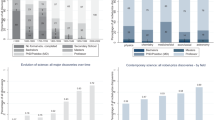Abstract
Scientific writing is an important skill for a career as a professional astrophysicist. However, very few researchers receive any formal training in how to write scientific research papers of high quality in an efficient manner. This Perspective is the first of a two-part self-help guide to scientific writing to address this skills gap. This part focusses on planning your academic research paper in astronomy. We discuss how to crystallize the ideas that underlie a research project, analyse how the paper can be constructed considering the audience and the chosen journal, and give an overview of the publishing process. Whether you are a student writing your first paper or an experienced author, you may find the ideas presented here useful.
This is a preview of subscription content, access via your institution
Access options
Access Nature and 54 other Nature Portfolio journals
Get Nature+, our best-value online-access subscription
$29.99 / 30 days
cancel any time
Subscribe to this journal
Receive 12 digital issues and online access to articles
$119.00 per year
only $9.92 per issue
Buy this article
- Purchase on Springer Link
- Instant access to full article PDF
Prices may be subject to local taxes which are calculated during checkout
Similar content being viewed by others
References
Ashby, M. How to Write a Paper (Univ. Cambridge, 2005); http://www-mech.eng.cam.ac.uk/mmd/ashby-paper-V6.pdf
Sterk, P. & Rabe, K. The joy of writing a paper. Breathe 4, 224–232 (2008).
Gopen, G. & Swan, J. The science of scientific writing. American Scientist (1 January 2018); https://www.americanscientist.org/blog/the-long-view/the-science-of-scientific-writing
Saramäki, J. How to Write a Scientific Paper: An Academic Self-Help Guide (Independently published, 2018).
Sterken, C. Writing a Scientific Paper I. The writing process. In Scientific Writing for Young Astronomers Vol. 50, 1–63 (EAS, 2011).
Sterken, C. Writing a Scientific Paper II. Communication by Graphics. In Scientific Writing for Young Astronomers Vol. 50, 65–170 (EAS, 2011).
Sterken, C. Writing a Scientific Paper III. Ethical Aspects. In Scientific Writing for Young Astronomers Vol. 50, 173–282 (EAS, 2011).
Stevance, H. F. Be concise, yet precise; a guide to scientific writing. Zenodo https://doi.org/10.5281/zenodo.4547903 (2021).
Bertout, C. & Schneider, P. Editorship and peer-review at A&A. Astron. Astrophys. 420, E1–E14 (2004).
Elements of style. Nat. Phys. 3, 581 (2007).
Chen, T. X. et al. Best practices for data publication in the astronomical literature. Astrophys. J. Suppl. Ser. 260, 5 (2022).
Knapen, J. H., Chamba, N. & Black, D. How to write and develop your astronomy research paper. Nat. Astron. https://doi.org/10.1038/s41550-022-01759-z (2022).
Wallace, M. & Wray, A. Critical Reading and Writing for Postgraduates 4th edn, Ch. 4 (SAGE, 2021).
Ahren, S. How to Take Smart Notes (CreateSpace Independent Publishing Platform, 2017).
Nishimura, K., Aoki, T., Inagawa, M., Tobinaga, Y. & Iwaki, S. Brain activities of visual thinkers and verbal thinkers: a MEG study. Neurosci. Lett. 594, 155–160 (2015).
Roig, M. Avoiding Plagiarism, Self-Plagiarism, and Other Questionable Writing Practices: A Guide to Ethical Writing (2015); https://ori.hhs.gov/avoiding-plagiarism-self-plagiarism-and-other-questionable-writing-practices-guide-ethical-writing
Vallejo, J. & Moreno Soto, J. Intergalactic Pachamama: Kichwa cosmology vs. western astrophysics. Folklife Magazine (21 June 2018); https://folklife.si.edu/magazine/intergalactic-pachamama-kichwa-cosmology-vs-western-astrophysics
Eriksson, S. & Helgesson, G. The false academy: predatory publishing in science and bioethics. Med. Health Care Phil. 20, 163–170 (2017).
Acknowledgements
We thank S. Comerón, S. Díaz-García, E. Knapen Almeida and L. Knapen Almeida, C. Martínez-Lombilla, R. Schödel and A. Watkins for comments on an earlier version of these notes. N.C. thanks T. Emil Rivera-Thorsen, M. Pompermaier and C. Usher for interesting discussions. Part of this Perspective is based on a scientific writing course delivered by J.H.K to mostly MSc and PhD students in Ethiopia and Rwanda. He thanks M. Pović and P. Nkundabakura for organizing those courses, and the students for participating. J.H.K. acknowledges financial support from the State Research Agency (AEI-MCINN) of the Spanish Ministry of Science and Innovation under the grant ‘The structure and evolution of galaxies and their central regions’ with reference PID2019-105602GB-I00/10.13039/501100011033, from the ACIISI, Consejería de Economía, Conocimiento y Empleo del Gobierno de Canarias and the European Regional Development Fund (ERDF) under grant number PROID2021010044 and from IAC project P/300724, financed by the Ministry of Science and Innovation through the State Budget and by the Canary Islands Department of Economy, Knowledge and Employment through the Regional Budget of the Autonomous Community. N.C. acknowledges support from the research project grant ‘Understanding the Dynamic Universe’ funded by the Knut and Alice Wallenberg Foundation under grant number Dnr KAW 2018.0067.
Author information
Authors and Affiliations
Contributions
The idea for this series stemmed from a workshop by the name ‘Scientific Writing for Astronomers’, organized by N.C. and D.B. at the Instituto de Astrofísica de Canarias, Tenerife, Spain, in October 2019. All authors further developed the ideas presented in this manuscript. N.C. and J.H.K. are the primary authors of all sections. D.B. wrote the first draft of the ‘Use your thinking style’ and ‘Avoiding plagiarism’ sections, and was involved in editing the final manuscript.
Corresponding author
Ethics declarations
Competing interests
The authors declare no competing interests.
Additional information
Publisher’s note Springer Nature remains neutral with regard to jurisdictional claims in published maps and institutional affiliations.
Rights and permissions
Springer Nature or its licensor holds exclusive rights to this article under a publishing agreement with the author(s) or other rightsholder(s); author self-archiving of the accepted manuscript version of this article is solely governed by the terms of such publishing agreement and applicable law.
About this article
Cite this article
Chamba, N., Knapen, J.H. & Black, D. How to plan your astronomy research paper in ten steps. Nat Astron 6, 1015–1020 (2022). https://doi.org/10.1038/s41550-022-01757-1
Received:
Accepted:
Published:
Issue Date:
DOI: https://doi.org/10.1038/s41550-022-01757-1
This article is cited by
-
Techniques for supercharging academic writing with generative AI
Nature Biomedical Engineering (2024)
-
How to write and develop your astronomy research paper
Nature Astronomy (2022)



